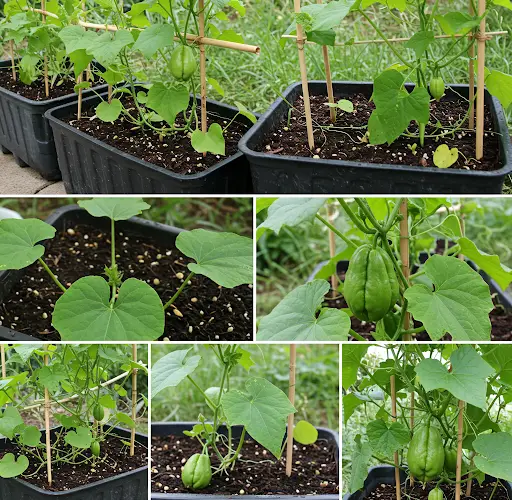Chayote, also known as vegetable pear or mirliton, is a nutritious and versatile fruit that can be grown easily at home—even on a small terrace. With the right technique, a single plant can produce an abundant harvest of crisp, tender fruits. While many gardeners attempt to grow chayote, not everyone knows the simple yet powerful methods that lead to heavy fruiting.
This guide reveals an easy, space-saving way to grow chayote at home, along with a little-known trick that can dramatically boost productivity—even for beginners.
Why Grow Chayote at Home?
Chayote is packed with fiber, vitamins, and antioxidants. It’s ideal for a wide range of culinary uses, from stir-fries to stews. The entire plant is edible—fruits, shoots, and leaves—making it one of the most valuable additions to a home garden.
It grows best in warm, humid climates and loves climbing, so it’s perfect for vertical gardening. With minimal effort, you can transform your terrace into a lush green canopy of climbing vines and hanging fruits.
Materials You’ll Need
To start your own chayote garden, gather the following:
-
1 mature chayote fruit (with a sprout if possible)
-
Large plastic pots or grow bags (minimum 15–20 liters)
-
Rich, well-draining soil mixed with compost
-
A strong trellis or support structure
-
Organic fertilizer (compost, manure, or banana peel mix)
-
Watering can or self-watering setup
Optional: banana peel and eggshell mixture as a natural fertilizer
Step-by-Step Guide to Growing Chayote on a Terrace
1. Select a Sprouting Chayote
Unlike other vegetables, chayote is grown by planting the whole fruit. Select a mature chayote—preferably one that has started sprouting naturally from the base. If it hasn’t sprouted yet, leave it in a dark corner for a few days until a green shoot appears.
Avoid cutting the fruit or removing the seed inside. The sprouted chayote will serve as both seed and starter fertilizer.
2. Prepare the Container
Choose a deep container with good drainage. Fill it with a rich mix of garden soil, compost, and a handful of sand or coco peat for better aeration. Chayote has a deep root system and benefits from loose, fertile soil.
Dig a shallow hole and place the entire chayote fruit sideways with the sprout facing up. Cover it lightly with soil, leaving the tip of the sprout exposed.
3. Build a Support Structure
As a vigorous climbing vine, chayote needs a strong trellis or vertical support system. Use bamboo poles, wooden stakes, or a mesh frame to help the vine climb. The more room it has to spread, the more flowers and fruits it will produce.
A terrace railing, balcony grill, or rooftop pergola can work perfectly as a natural trellis.
4. Watering and Sunlight
Chayote prefers consistent moisture but doesn’t like waterlogged soil. Water regularly to keep the soil moist, especially during dry periods. If using a self-watering system, check the reservoir weekly and refill as needed.
Place the pot in a sunny location. Chayote requires 6–8 hours of sunlight daily for optimal growth.
5. The Secret Fertilizer Mix
Here’s the trick many gardeners overlook: combining banana peels and eggshells creates a powerful organic fertilizer. Chop one banana peel and a few dried eggshells, and bury them near the base of the plant every 2–3 weeks. This provides essential potassium and calcium, which promote flowering and fruit development.
You can also use compost tea or diluted fish emulsion to boost growth during the flowering stage.
6. Pruning for Productivity
Once the vine reaches a good length, pinch off the tips to encourage branching. More branches lead to more flowers and eventually more fruits. Also, remove older yellowing leaves to improve airflow and reduce pest problems.
When the plant begins flowering, you may notice male flowers first. Female flowers will appear later and are distinguished by a small swelling behind the petals. Gently shake the vines in the morning to help with pollination.
7. Harvesting
Chayote fruits are usually ready for harvest about 4–5 months after planting. Pick them when they are still tender and green—before they harden or become overripe. Use pruning shears to avoid damaging the vines.
Regular harvesting encourages the plant to produce more fruit. Under good conditions, a single plant can yield 30 to 50 fruits in a season.
Final Tips
-
Chayote vines can grow for several years if well cared for. After harvest, prune the plant and refresh the soil annually.
-
Watch for pests like aphids or mites, especially in warmer climates. Use neem oil or soapy water as a natural remedy.
-
If space is limited, consider training the vine in a circular pattern over a rooftop pergola or trellis arch.
Conclusion
Growing chayote at home is easier than it looks. With a sprouted fruit, a sturdy container, and a sunny terrace, you can enjoy fresh, homegrown chayote season after season. The secret lies in consistent care, clever feeding methods, and giving the plant the support it needs to flourish.
Whether you’re an urban gardener or simply looking to grow more of your own food, chayote is a rewarding, space-saving crop that delivers both beauty and bounty.



